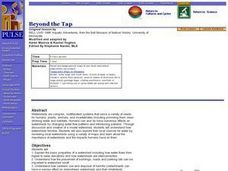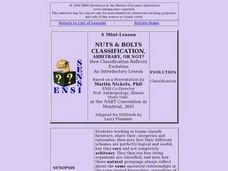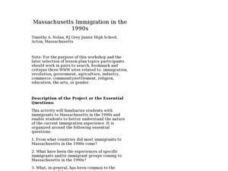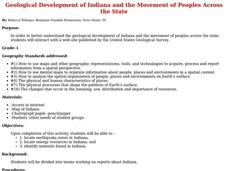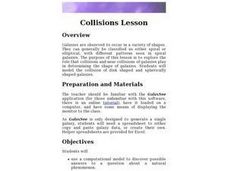Curated OER
Shapes at Work
Students use their classroom to look for various types of shapes. In their science journals, they record the shapes they find and identify those that can be used to solve problems or build structures. They share and post their sketches...
Curated OER
Math: a World of Symmetry
Learners expand their knowledge of quadrilaterals and identify basic symmetrical forms. Over three weeks, they explore the math, application, and discussion of symmetry. After conducting Internet research, students create symmetrical...
Curated OER
FIELD NOTE SCAVENGER HUNT
Young scholars explore how to take good field notes through a scavenger hunt.
Curated OER
Springtime
Students examine the use of KidPix software before making a slide show that shows their ideas about spring. They listen to books about seasonal change. Next, they draw a spring picture, write a sentence and their name on their KidPix...
Curated OER
Beyond the Tap
Students explain the basic properties of a watershed including how water flows from higher to lower elevations and how watersheds are interconnected. They comprehend how the placement of buildings, roads, and parking lots can be...
Curated OER
Hurricanes Are They Coming to Your Neighborhood?
Students study weather systems, hurricanes and tropical storms. They predict landfall of hurricanes and tropical storms.
Curated OER
Symmetry: Theory, Reality and Art!
Students explore the concept of geometric symmetry. In this geometric symmetry lesson, students walk around their school and take pictures of objects that demonstrate symmetry. Students use Microsoft Paint to draw the lines of symmetry...
Curated OER
Suitcase, Parfleche and 'Isaptakay
Third graders explore farfeche and how the Nez Perce people use natural materials to derive colors for their artwork. They explore traditional paints and dyes used by the Nez Perce and create their own parfleche 'isaptakay.
Curated OER
Nuts & Bolts: is Classification, Arbitrary, Or Not?
Students, in groups, classify furniture, share their categories and rationales, then note how their different schemes vary, perfectly logical and useful, but completely arbitrary.
Curated OER
Build a Space Shuttle
Students explore the concept of space. In this space lesson, students pretend to be aerospace engineers. Students build space ships out of cardboard tubes. Students discuss what aerospace engineers do. Students model their space ships...
Curated OER
Multiplying Microbes
Students examine environmental conditions that effect bacteria growth. They culture bacteria, design and conduct an experiment, and identify the conditions that effected the bacteria growth using the scientific method.
Curated OER
Before We Travel, We Research
Young scholars conduct research on a historical site in preparation for a field trip. In small groups, they conduct research, and present the information to the class in the form of a PowerPoint presentation or poster.
Curated OER
Who Am I and Who Are You?
Students document their unique characteristics through photography. In this self-discovery instructional activity, students take photographs of themselves and others. As a class, they discuss similarities and differences, and sort,...
Curated OER
Social Studies: Analyzing Massachusetts Immigration
Students investigate immigration in Massachusetts during the 1990's. They research a series of questions pertaining to immigration, including their experiences, obstacles, and countries of origin. They graph the five most prevalent...
Curated OER
Geological Development of Indiana and the Movement of Peoples Across the State
Fourth graders examine the geological development of the state of Indiana. Using the internet, they interact with the United States Geological Survey. They identify earthquake zones and energy resources in the state. They work...
Curated OER
Geological Development of Indiana and the Movement of Peoples Across the State
Learners are introduced to the geological development of the state of Indiana. Using the internet, they visit the U.S. Geological Survey and locate the earthquake zones in the state. In groups, they locate and identify the energy...
Curated OER
Geography Made Fun with Technology
Young scholars incorporate knowledge box into their classroom activities. In this technology integration lesson, students fill out a graphic organizer using Glossopedia to analyze a new subject.
Curated OER
Calculating the Average Mass of the Newly Discovered Element: Bean
Students determine the average mass of a new element using masses from three isotopes. In this chemistry instructional activity, students explain what an isotope is. They discuss their importance and uses.
Curated OER
Collisions Lesson
Tenth graders explore the role that collisions and near collisions of galaxies play in determining the shape of galaxies. They model the collision of disk shaped and spherically shaped galaxies.
Curated OER
SC Populations Along Major Interstates
Students examine the population among the interstates in South Carolina. Using the internet, they identify the counties and roads and compare it with their own drawing.
Curated OER
Weather Conditions During the Spring Monarch Migration
High schoolers keep a detailed record of weather patterns during the spring migration of the monarch butterfly. The use of weather reports is used to form a class data sheet. This lesson connects to the skills of graphing and critical...
Curated OER
Comparing Cities
Students research the characteristics of cities in two different geographical areas. Using the internet, they take notes on the information they collect and record their observations on the two cities. They discover how the location...
Curated OER
How Does Temperature Vary Over Time?
Students examine the temperature flucuations on the Earth. After defining new vocabulary, they identify the flucuations of the Earth on a map. As a class, they develop a hypotheis on the temperature variation by examining the data.
Curated OER
Testing the Hypothesis
Students create and conduct various experiments to determine the origin of a family artifact, and then determine whether their results were successful. Students summarize their results and evaluate whether their hypotheses were correct.






